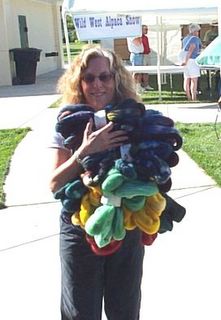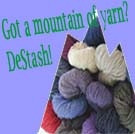Scrounging for Yarn
I am lucky to be better off financially than just about ever in my entire adult life, but I had to really scrounge for yarn for a few decades and so I decided to include a few tips about picking up yarn at thrift stores and yard sales... yes, you can sucessfully do this, but the best quality is often going to be leftovers from someone elses' finished project. This leads you to lots of striped or colorwork garments, as well as smaller items such as socks, hats and mittens. I also made a few yoked sweaters that were striped, based on four sections that keep increasing and turn into front, back and sleeves... I will have to see if this design is available online; originally got it from an old issue of Threads.

Pink striped sweater made from collection of thrift store yarns

Blue and purple sweater; blue yarn was a thrift store find, while lilac lace inset was left over from another project. I didn't test the color fastness of the blue yarn and it bled slightly into the lilac, so learn from my mistake and test your treasures before using
You also need to become a label reader - just like food shopping. Unfortunately, the yarn industry has been late in coming around to complete labelling (another similarity to the food industry). If you are lucky, you will have the complete fiber content, as well as the weight of the skein, and will be able to tell from how tightly the label band fits if there is a significant amount of the yarn already used up. Now, if you are better than lucky, the label will also have yardage and gauge information, but if not, you can consult the interchangeable yarn table at Vintage Knits to figure out approximately how much treasure you've got. Today's patterns mostly feature accurate information about how much yarn you will need, so you can concoct a design to suit your finds.
The most valuable tip I have about "found" yarns from thrift stores is to pop them into ziplock bags and throw them into the freezer for at least two weeks before using them... this will kill any moth eggs. Wool moths are the bane of knitters everywhere, and I have had to abandon using a skein of what appeared to be perfectly good wool on the surface, but turned out to be chewed through somewhere, producing short, stubby lengths of yarn.
While you are at the thrift stores, keep an eye out for sweaters to purchase for cheap and unravel for their yarn. Mohair is particularly a good one to keep an eye out for... often it will be hand-knit in a large format and will give you a very generous amount of yarn to work with. Check out Ashley's directions and photos on how to unravel a sweater; don't buy those commercial ones with cut and sewn seams, as you will not get a continuous length of yarn.
The toughest find for me to deal with was picking up someone else's knitting bag at a flea market, complete with almost-finished sweater... now do I try to finish it, even though it's not to my taste, do I keep all the other goodies and try to pass the unfinished project along, do I unravel and reuse? That white rayon-looking sweater is still sitting in a bag in my stash room...

Pink striped sweater made from collection of thrift store yarns

Blue and purple sweater; blue yarn was a thrift store find, while lilac lace inset was left over from another project. I didn't test the color fastness of the blue yarn and it bled slightly into the lilac, so learn from my mistake and test your treasures before using
You also need to become a label reader - just like food shopping. Unfortunately, the yarn industry has been late in coming around to complete labelling (another similarity to the food industry). If you are lucky, you will have the complete fiber content, as well as the weight of the skein, and will be able to tell from how tightly the label band fits if there is a significant amount of the yarn already used up. Now, if you are better than lucky, the label will also have yardage and gauge information, but if not, you can consult the interchangeable yarn table at Vintage Knits to figure out approximately how much treasure you've got. Today's patterns mostly feature accurate information about how much yarn you will need, so you can concoct a design to suit your finds.
The most valuable tip I have about "found" yarns from thrift stores is to pop them into ziplock bags and throw them into the freezer for at least two weeks before using them... this will kill any moth eggs. Wool moths are the bane of knitters everywhere, and I have had to abandon using a skein of what appeared to be perfectly good wool on the surface, but turned out to be chewed through somewhere, producing short, stubby lengths of yarn.
While you are at the thrift stores, keep an eye out for sweaters to purchase for cheap and unravel for their yarn. Mohair is particularly a good one to keep an eye out for... often it will be hand-knit in a large format and will give you a very generous amount of yarn to work with. Check out Ashley's directions and photos on how to unravel a sweater; don't buy those commercial ones with cut and sewn seams, as you will not get a continuous length of yarn.
The toughest find for me to deal with was picking up someone else's knitting bag at a flea market, complete with almost-finished sweater... now do I try to finish it, even though it's not to my taste, do I keep all the other goodies and try to pass the unfinished project along, do I unravel and reuse? That white rayon-looking sweater is still sitting in a bag in my stash room...













0 Comments:
Post a Comment
<< Home